 |
 |
| DOCUMENTATION |
| - Current repositoriesí shortages |
| - Towards a learning object flexible definition |
| - SLOR ontology |
| - A flexible repository: SLOR |
| FLEXIBLE METADATA STORING - ELSEM REPORT - |
| DOWNLOAD |
| WORKING GROUP |
| Further Work |
| Towards a learning object flexible definition |
Recent studies about the unification of the existing concepts into a single definition of learning object suggest the possibility of coexistence of all the available definitions (McGreal, 2004). According to McGreal’s study on existing learning object characte-rizations, five definitions –ranging from general to specific– coexist:
-- figure 1 -- According to the first definition, the use of an object is what determines whether or not the object becomes a learning object, and thus everything that exists (the univer-sal concept) can be considered a learning object. Nevertheless, in software-based representations, the only objects considered in practice as existing (in the sense of being able to ‘talk’ about them) are those that are represented. In our case, the scope of representation is that of the different elements of the ontology. Taking OpenCyc as a case of ontological representation, the term Thing, defined in Opencyc as “the collection which, by definition, contains everything there is”, subsumes anything that may eventually be considered a learning object. This definition has the obvious draw-back of not adding any defining characterization to the concept. Learning can be considered an Event, defined in Opencyc as “a dynamic situation in which the state of the world changes.” Accordingly, everything that is linked to the representation of learning activities, or declared to have educational purpose in some way, should be considered a learning object. In addition, some axioms could automatically classify some things as learning objects. For example, “every Book classifies as a learning object”. These are examples of concrete characterization of classes of learning objects, which can be used for practical applications. In consequence, the first definition may be interpreted in the following way: “[1] LearningObject-AsAnything: learning objects are things that either have been used in learning events or have been provided with descriptions that specify possible usages in learning”. The latter part of the sentence still requires much clarification, but it can be used provisionally until more detailed clarifications are proposed. An example of learning object that fits this definition would be a text book, a pen, or a printed copy of this chapter. Figure 1 depicts both this and the rest of definitions being discussed. The second definition introduces the concept of “digital object” in an attempt to further specifying that learning objects are artifacts. The term ComputerFileCopy is defined in Opencyc as “an information bearing thing that is identified as a unit by a unique name, and which is object-like in an important respect”. Examples include individual image files, text files, sound files and executables stored on some ComputerStorageDevice (defined as “the collection of devices used by computers to store information”). Consequently, the term ComputerFileCopy can be used as a possible characterization of the concept, since it requires unique identification, and is not restricted to “data” but instead subsumes programs in a general sense. Thus the following definition can be used “[2] LearningObject-AsAnythingDigital: learning objects are LearningObject-AsAnything instances that are subsumed by ComputerFi-leCopy”. An example of learning object that fits this definition would be the PDF version of this chapter. The third definition introduces a consideration of purpose. In this case, the purpose should be interpreted as something that was present in the act of Designing (“the act of designing something, be it clothing, cars, computer chips or buildings”, as defined in OpenCyc) the learning object, which entails the associated restriction of learning objects to be Artifacts, i.e. at least partially tangible things intentionally created by an Agent (or a group of Agents working together) to serve some purpose or perform some function, which separates them from “natural” things. This leads to definition [3]: “LearningObject-AsAnythingWithEducationalPurpose: learning objects are Lear-ningObject-AsAnything instances that have somewhat a record of the educational purpose put in the object in the act of its Designing”. Here “record” is used in a ge-neric sense and it may simply include the trace of the one that created it. Further, it can be considered that some tacit traces of an object again exist, as having being created with an educational purpose. An example of learning object that fits this definition would be a digital unit including both a PDF version of this chapter purposefully designed to serve a particular educational purpose, and a metadata record including specific information on the pedagogical use and goals of the chapter in an educational context. Since the purpose in the design is an intellectual process, a notion of “record” of it should be introduced. Such purpose may be internal to the learning object, e.g. the “objectives” section in a Web page, but it could also be tacit, i.e. when it takes a form that is easily recognizable as an educational artifact. This may be the case of slide presentations. That notion of “record” of the purpose is deliberately kept open to divergent interpretations. |
